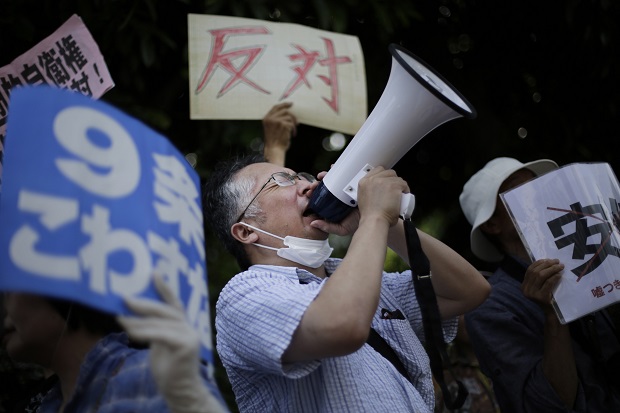
People protest outside the Japanese prime minister’s office in anticipation his government will reinterpret the constitution to allow Japan’s military a larger international role in Tokyo, Tuesday, July 1, 2014. About two thousand people demonstrated to demand that Abe’s Cabinet scrap its plan, intended to allow the Japanese military to help defend other nations. It would be one of the biggest changes in Japan’s security policy since World War II. The placards from left to right read: “Do not scratch the article 9,” “We oppose,” and “No to security treaty.” AP
TOKYO — Japan took a step away Tuesday from an American-drafted constitution that has long kept its military shackled, approving a plan to allow greater use of a force that was vanquished at the end of World War II.
In one of the biggest changes to Japanese security policy since the war, the Cabinet approved a reinterpretation of the constitution on military affairs.
The contentious move will allow the military to help defend other nations in what is known as “collective self-defense.”
Previous governments have said that Japan’s war-renouncing constitution limits the use of force to defending Japan.
Prime Minister Shinzo Abe, in a televised news conference, said the shift is intended to protect the lives and security of the Japanese people. For example, he said, Japanese warships would be able to help protect U.S. ships that were fighting to defend Japan.
“This is for the happiness of the Japanese people,” he said.
But not everyone was happy. About 2,000 opponents protested earlier Tuesday outside Abe’s office, saying that any changes to the constitution should be made through a public referendum, not simply a Cabinet decision to reinterpret it.
“For 70 years, Japan has kept its peace with its constitution,” said 67-year-old protester Toshio Ban. “What are we to do with that stupid man trying to trample over the precious constitution?”
Abe, who has made raising the country’s military profile a cornerstone of his nationalist policies, pushed hard for the change. He cited a deteriorating security environment, notably China’s military rise and North Korea’s missile and nuclear threats.
Chinese Foreign Ministry spokesman Hong Lei voiced Beijing’s opposition at a daily briefing.
“Beijing opposes Japan’s act of hyping the China threat,” he said, adding that the new policy “raises doubts about Japan’s approach to peaceful development.”
Written under U.S. direction after World War II, the 1947 constitution says the Japanese people “forever renounce war as a sovereign right of the nation.” It also says that “land, sea, and air forces, as well as other war potential, will never be maintained.” The article was crafted to prevent a repeat of Japan’s invasion and brutal occupation of wide swaths of Asia.
The interpretation of the ban has been relaxed over the years, starting with the introduction of a “police” force in 1950 during the Korean War, which became a military dubbed the Self-Defense Force in 1954.
The government has no immediate plans to change the constitution, which has remained unaltered since it came out. But Abe and subsequent governments will now be empowered to authorize greater military engagement under the new interpretation of the charter.
Opponents say the new policy could open the door for Japan’s eventual participation in joint military actions such as the war in Iraq.
Abe and other leaders of his ruling Liberal Democratic Party say Japan will stick to its pacifist pledge. An agreement with junior coalition partner New Komeito includes restrictions on when Japan can exercise collective self-defense.
“Japan’s status as a peaceful country will not change,” Abe said.
The U.S., now allied with Japan, supports the move.
Takeshi Iwaya, a lawmaker who chairs a ruling party research commission on security, said Japan has said it won’t repeat the mistakes of World War II, but that alone is no longer enough to preserve peace.
“What we are trying to do now is to play a more proactive role in cooperating with regional countries in setting up a framework to protect the peace and stability of the region,” he said in an interview.
Buddhist-backed New Komeito initially opposed the change, and Tuesday’s Cabinet decision came after weeks of negotiations between the two parties.